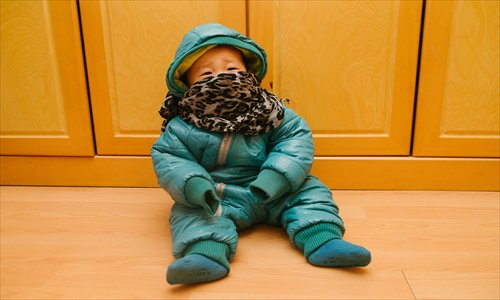HOME >> METRO BEIJING
Lay off the layers
By Li Lin Source:Global Times Published: 2015-10-18 19:23:01
Experts warn Chinese parents not to overdress their children

Chinese parents often believe that dressing warm is important, but too many clothes could be harmful to a baby's health. Photo: Li Hao/GT
When Jiang Qi took her 14-month-old son to the doctor last month for a fever, her pediatrician gave her feedback she hadn't expected. The moment he saw her son, he told her to remove several layers of clothing. Jiang was overdressing her son, and the doctor pointed out her son's face was red and even breaking out into a sweat.As soon as October hit, Jiang had started dressing her son in warmer layers, including a thick cotton undershirt, a sweater, and a jacket for the upper body, and the same set of cotton underwear, woolen underpants and jeans.
"Beijing's weather has been changing sharply, and I am afraid that my son might catch a cold," said Jiang. "And I was wondering why he still had a fever even though he was protected by so many clothes."
According to Wu Qingchang, a pediatrician at Dongfang Hospital affiliated to Beijing University of Chinese Medicine, there have been more than 100 children that have come to the hospital each day this month with a fever.
"Most of them are not suffering because of the cold weather, but from 'infant muggy syndrome' (IMS)," said Wu. "Having the children more heavily dressed than necessary is definitely not good for the child."
Wu said when children are dressed in too many clothes or in a thick blanket, the risk of IMS rises. This is partly because children's temperature regulation, which is controlled by the central nervous system, is not fully developed, especially in babies under 5 months old.
"Chinese parents often think that wearing more is better than wearing less and that feeling hot is better than feeling cold, which is very wrong," said Wu. He also said that a fever is one of the lightest symptoms of IMS and that serious symptoms include oxygen deficit, dehydration, and even brain damage.
Wu said there are two ways to know whether a child is wearing too much. First, touch the child's collarbone. If it feels neither too hot, nor too cold, then the clothes the child is wearing are fine. Second, touch the child's back. If it is sweaty or too hot, then the child must be wearing too much.
Wu said no matter what season it is, parents should dress their children in clothes that have sweat-absorbent fabrics, such as cotton, silk or linen. Parents should make sure they are not too tight.
Jiang went to Germany and France in the winter of 2013 on a business trip, and although she did not have a child at the time, she was surprised to see how the parents there dressed their children.
"I saw many infants only wearing very thin clothes, outside in the early winter," said Jiang. She said she thought there were older children around 10 years old who were also wearing too few clothes. "Most girls I saw on the street were only wearing thin stockings and short skirts, and some boys wore cropped trousers, which is unimaginable in China."
According to a 2014 report by Xinhua News Agency, in Japan some parents send their children outdoors to play wearing only shorts and bring them to the river for a bath in the winter to cultivate their minds and develop immunity against bad external environments.
According to Li Jianzhong, a psychologist based in Beijing, one of the reasons that Chinese parents often overdress their children is because they spoil them - they do not want their children to suffer even a little pain.
"The recent increasing cases of IMS shows us that Chinese parents should learn from foreign parents, especially those in Japan, who think hunger and cold is inevitable in life," said Li. "A good parent should respect the laws of nature and society."
Posted in: Intel